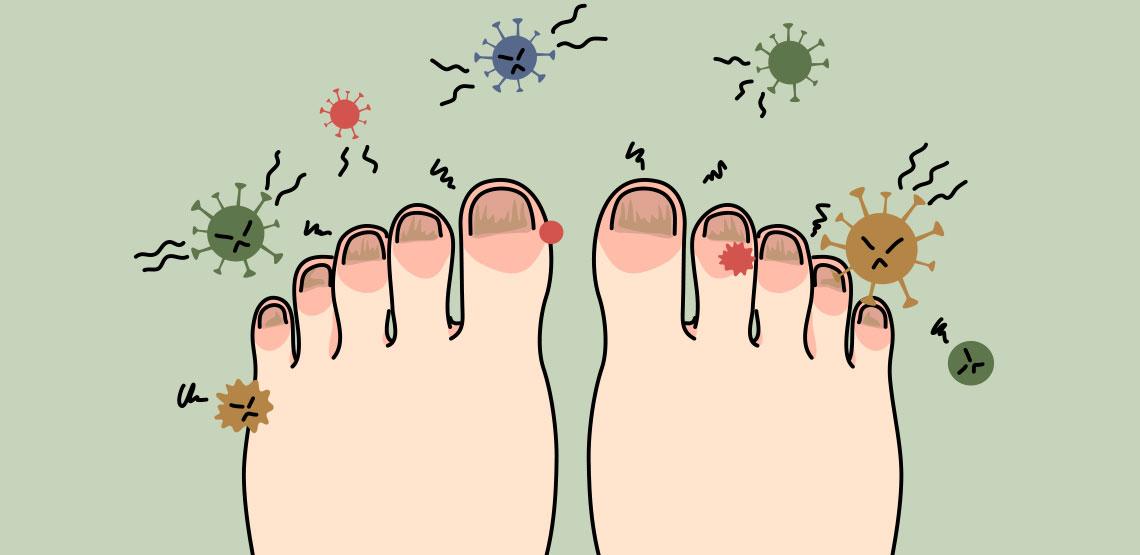Prescription and Natural Nail Fungus Treatment
Nail fungus involves a widespread fungal infection that most commonly affects the toenails but may also affect the fingernails. Toenail and fingernail fungus occurs when fungi find its way in between the nail and the nail bed, usually through a cut or crack in the toe or finger, resulting in a nail fungal infection.
Approximately 90% of toenail fungus infections are caused by dermatophytes. When a dermatophyte is causing toenail fungus, it’s called tinea unguium, which is also referred to as onychomycosis. A dermatophyte is a type of mold that requires keratin to grow, and keratin is the major structural component of nails that make them hard.
While nail fungus infections are unsightly, they typically don’t cause pain. Nail changes that may occur with a nail fungus infection include:
- White, brown or yellow color changes of the nail.
- Cloudy or chalky appearance in certain spots of the nail.
- Thickened nails.
- Nail separation from the nail bed.
- Cracks in the nail.
If you suffer from nail fungus, you’re likely looking for the best nail fungus treatment. In this article, we’ll discuss both prescription and natural nail fungus treatment options.
Prescription Nail Fungus Treatment Options
Treatment for toenail or fingernail fungus typically begins with a dermatologist or podiatrist trimming the infected nail(s) back to where the nail attaches to the toe or finger. They may also scrap debris from under the nail, helping to get rid of some of the fungus. However, to get rid of the infection, further treatment is often needed.
There are various fingernail fungus and toenail fungus treatment options available, including:
1. Oral Antifungals
Prescription oral medications include terbinafine, fluconazole, griseofulvin and itraconazole. These medications are taken daily for several months, and even longer in some cases. Oral antifungals take about two months to cure fingernail fungus, and about three months for toenail fungus treatment.
These medications are not recommended for everyone as they have the potential to affect the liver and interact with various other medications. If your doctor does prescribe this type of treatment, regular blood tests are often needed to monitor for medication side effects.
2. Topical Medications
Topical medications include amorolfine, ciclopirox, efinaconazole and tavaborole. In mild cases, topical medications might be all that is needed to get rid of the infection. They are applied to the affected nails as directed (some are daily, and some are weekly).
This treatment works by stopping new fungus from developing as the nail grows. Fingernail fungus typically takes about 4–6 months to grow out, while toenail fungus typically takes 12–18 months to grow out.
This type of medication provides the best results when combined with oral antifungal medication. Side effects of topical medications are usually mild and may include swelling and redness, burning or stinging during application, rash and ingrown toenails.
3. Nail Removal
Severe or resistant nail fungus may require nail removal to get rid of the infection. Nail removal can occur non-surgically with a chemical applied to the nail, or surgically. After nail removal, a new nail grows back.
If the infection is still present, a dermatologist can treat the nail so that it doesn’t grow back.
4. Laser Therapy
This method uses a laser beam and special lights directed at the nail to treat the fungal infection. Cure rates for laser therapy are lower than those for oral and topical medications.
Related Search Topics (Ads)
Natural Nail Fungus Treatment Options
While there are various prescription nail fungus treatment options available, they often have bothersome side effects. If you’re looking for natural nail fungus treatment options, there are many available, including:
- Tea tree oil. This essential oil has antifungal and antiseptic properties and can be applied to the affected nail twice per day.
- Vick’s VapoRub. This topical ointment has camphor and eucalyptus oil and can be applied to the affected nail at least once a day.
- Oregano oil. This oil contains thymol, which is believed to have antifungal and antibacterial properties, and can be applied to the affected nail two times per day.
- Olive leaf extract. This extract contains an active substance called oleuropein that is believed to have antifungal and antimicrobial properties, as well as immune boosting effects. An olive leaf salve can be applied to the affected nail, or it can be taken orally in capsule form. Research has shown that taking 1–3 olive leaf capsules with meals twice per day is more effective than applying olive leaf salve for toenail fungus treatment.
- Garlic. Garlic has antifungal and antimicrobial properties and can be crushed or chopped and applied to the affected nail for 30 minutes a day, or can be taken in capsule form.
Natural home remedies may be effective for mild to moderate cases of nail fungus. However, natural treatments typically take longer to cure the infection compared to prescription medications, so you may not see results for several months or more, and unfortunately, reinfection is common.
Final Notes
The best nail fungus treatment will depend on a variety of factors including your symptoms and lifestyle. If natural nail fungus treatment options fail, working with a dermatologist or podiatrist to create an individualized treatment plan is your recommended.
Often, nail fungus treatment combining oral antifungal medications with topical antifungal medications provide the best outcomes. It’s important to remember that toenail fungus treatment takes a long time and is not always successful, and even if treatment does work, toenail fungus often comes back.
It’s important to practice good hygiene and take care of your feet to reduce the chance of toenail fungus coming back.


